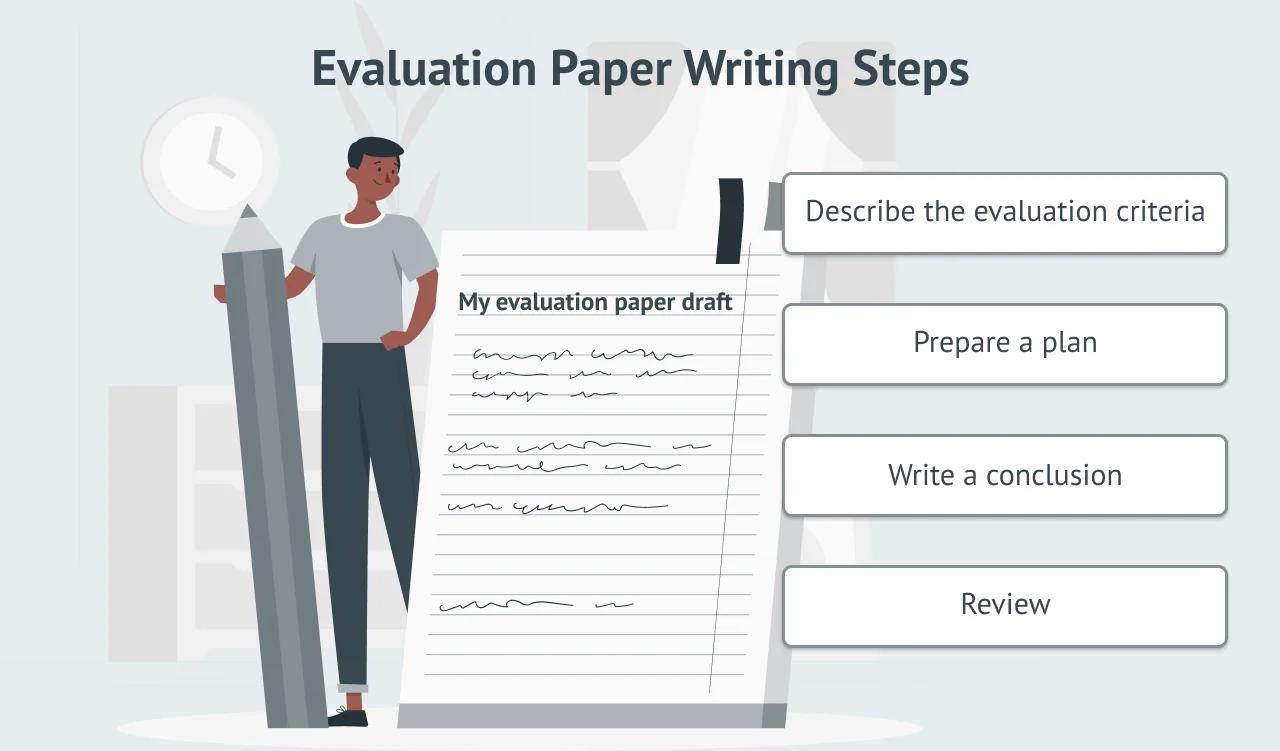All students involved in academic writing sooner or later come across various essay genres, each with the challenges they present but also with potential and opportunities for growth. Somewhere halfway along this range, you’ll find an essay style that requires a keen eye, critical thinking skills, and judgment: the evaluation essay. What seems difficult at first, later becomes an easy routine task. All you need to know is the essay’s core elements, subject, judgment, criteria, evidence, and a few tips on how to put them together.

✅ AI Essay Writer ✅ AI Detector ✅ Plagchecker ✅ Paraphraser
✅ Summarizer ✅ Citation Generator
📝 What’s an Evaluation Essay?
There is a simple way to explain what an evaluation essay is. It resembles giving your opinion about something but with a twist. Just saying if something’s good or bad isn’t enough – you need to elaborate and clarify why you say something, believe in something, or convince someone about something, like what language you study and why exactly. Think of it as a way to analyze and critique a movie, a book, or even a restaurant you love. Or hate, it doesn’t matter. But instead of just saying, “I liked it,” or “It stunk,” you’re explaining and providing arguments.
| The main purpose of evaluating papers is to offer a well-informed strong conclusion, aiming for rationality and unbiasedness through sound judgment, appropriate criteria, and clear evidence. |
Along with traditional introduction and conclusion that go without saying, every evaluation essay contains several essential components: criteria, judgments, evidence, counterarguing, and credibility. Let us take a closer look at these components and how they work together and contribute to a well-balanced, convincing evaluation essay.

Presenting the subject
Imagine you’re introducing a friend to a new movie. You’d start by telling them what it’s about, who’s in it, and maybe where it takes place. In an evaluation essay, you do the same thing. You give your readers all the necessary background info so they already get some picture and basic understanding of what you’re talking about. For example, if you’re evaluating a restaurant, you’d describe its ambiance, the type of cuisine it serves, its location, and maybe price range.
Asserting an overall judgment
After you’ve given the subject, it’s time to share your prevailing opinion. This is where you say if it’s good, bad, or somewhere in between. But remember, it’s not enough to just say, “I loved it” or “It was nothing to write home about.” You need to explain why you feel that way, and what created those favorable or displeasing impressions. Maybe the movie had great acting but a weak plot, or the book was well-written but had unlikeable characters. Whatever your judgment, make sure you back it up with reasons.
Giving reasons and support
You don’t just throw out your opinion and leave it hanging. You back it up with reasons and evidence. This could be examples, facts, or even personal experiences. Going back to the restaurant example, if you say the food was amazing, you might explain how flavorful the food was, or mention specific dishes that stood out to you. Providing substantial evidence helps strengthen your evaluation and makes your argument more convincing.
Counterarguing
Overwhelmingly agreeing with oneself may seem overly subjective and, as a result, reduce the level of trust and credibility of the statement in your essay. You also consider other viewpoints and argue against them. This shows that you’ve considered different perspectives and strengthens your argument by addressing potential objections upfront. For instance, if someone argues that the restaurant you’re evaluating is overpriced, you might counter by pointing out the high quality of ingredients or the exceptional service as reasons why the prices are justified.
Establishing credibility and authority
You want your readers to trust what you’re saying. So, you need to show them why you’re a reliable source. Maybe you’re an expert on the topic, or you’ve done thorough research. Either way, you make sure your readers know they can trust you. This might involve citing sources, providing background information on your expertise, or demonstrating your firsthand experience with the subject matter. Show them your restaurant review on Yelp with dozens of likes and approving comments! By establishing credibility and authority, you improve the persuasiveness of your evaluation essay.
📝 How to Write an Evaluation Essay
Now that we’ve explored the concept and covered the basics, it’s time to roll up our sleeves and get closer to the nitty-gritty of actually writing an evaluative essay. At AcademicHelp we’ve been there not once, not twice, and will guide you through each step of the process with clarity and confidence.
Describe the evaluation criteria
Before you can begin writing, you need to establish the criteria by which you’ll be evaluating your subject. They should be like the lenses through which you’ll examine the subject’s various aspects. Are you evaluating a movie? Consider criteria like plot, cast, acting, cinematography, music, and overall impact. Assessing a restaurant? Look at criteria such as food quality, service, atmosphere, and value for money. Take some time to brainstorm and define your criteria before starting the writing process.
Write a plan
Once you have your criteria ready to be applied, it’s time to map out your essay. Start by outlining the main points you’ll cover in each body paragraph, based on the criteria you’ve established. Think about the order in which you want to present your arguments and how you’ll transition between them. A well-thought-out plan should be like a roadmap for your essay, keeping you on track and maintaining a logical flow of ideas, not letting your thoughts drift away elsewhere.

Write an evaluation essay
With your plan in hand, it’s time to start writing! Begin with a strong introduction that grabs your readers’ attention and states the purpose of your evaluation. Then, move on to the body paragraphs. Each has to focus on a different aspect of the subject and follow the structure we outlined earlier: subject, judgment, criteria, and evidence. Make sure to provide clear and compelling reasons to support your opinion and tie everything together with a cohesive conclusion that leaves a lasting impression.
Write a conclusion
You’re almost there. In your conclusion, summarize the main points of your essay and reiterate your overall judgment. Reflect on the significance of your evaluation and its implications for the subject. Give your readers something to think about—a thought-provoking question, a call to action, or a concluding idea that links all sections of your essay like a thread.
Review the finished essay
Before you submit the paper, take a moment to review and revise your essay. Check for any grammatical errors, typos, or awkward phrasings that might distract from your argument. Make sure your essay flows smoothly from start to finish and that your ideas are well-supported by evidence. And don’t forget to double-check that you’ve addressed all aspects of the evaluation criteria you established earlier. Once you’re satisfied with your paper, pat yourself on the back for a job well done, and send it off into the world with confidence.
📈 Evaluative Thesis Grading Criteria
We may believe we’ve learned enough about writing an evaluation essay from the perspective of authorship. The topic is chosen, thoughts are developed, and the structure is established. It looks like all essential elements for success are in place. However, doubts and unsettling questions often remain, such as “Have all aspects been considered?” or “How can I avoid overlooking anything?” Additionally, there’s uncertainty about what should be omitted from the essay. Understanding the areas where teachers focus when assessing such essays can assist in double-checking your work. Frequently, elements that might seem inconspicuous to the author are the first flaws that the professor notices.
When grading an evaluation essay, instructors typically look for several key criteria to assess the quality of the student’s work. Look at your paper again a day or two after you’ve written it, and make sure it checks all the boxes. Here are some criteria used to grade an evaluation thesis:
☑️ Clarity and Coherence:
Is the essay well-organized and easy to follow? Are the ideas presented logically and coherently? Clarity in expression and coherence in structure are fundamental for effective communication.
☑️ Thesis Statement:
Does the essay have a clear and concise thesis statement that presents the overall judgment or evaluation of the subject? The thesis statement should be prominently stated in the introduction and guide the reader throughout the essay.
☑️ Use of Evidence:
Are the judgments and evaluations supported by relevant and convincing evidence? Students should provide specific examples, facts, and arguments to justify their assessments and demonstrate critical thinking skills.
☑️ Depth of Analysis:
Does the essay provide insightful analysis and thoughtful commentary on the subject? Grading criteria often include the depth of analysis, examining how well students engage with the nuances of the subject and demonstrate a deeper understanding of its complexities.
☑️ Critical Thinking Skills:
Does the student demonstrate critical thinking skills by considering alternative viewpoints, anticipating counterarguments, and addressing them effectively? Teachers look for evidence of analytical thinking and the ability to evaluate evidence objectively.
☑️ Use of Language and Style:
Is the essay written in clear, concise, and engaging language? Are grammar, punctuation, and spelling used correctly? Additionally, does the student demonstrate a mastery of academic writing conventions and adhere to the guidelines provided?
☑️ Originality and Insight:
Does the essay offer original insights or perspectives on the subject? Grading criteria may include the student’s ability to offer fresh perspectives or innovative interpretations that contribute to the discourse on the topic.
☑️ Compliance with Instructions:
Does the essay fulfill the requirements and guidelines provided by the instructor? This includes meeting the specified word count, formatting guidelines, and any other instructions outlined for the assignment.
You now have all you need to know about writing an excellent evaluation essay. It is important to remember that, while creativity is always an inspiration when it comes to writing, we must also consider what type of essay we are workin on, what its purpose is, and who its intended audience is. By balancing all of this and following the right steps at each level, you will be successful with your assessment thesis.
FAQ
Follow us on Reddit for more insights and updates.




Comments (0)
Welcome to A*Help comments!
We’re all about debate and discussion at A*Help.
We value the diverse opinions of users, so you may find points of view that you don’t agree with. And that’s cool. However, there are certain things we’re not OK with: attempts to manipulate our data in any way, for example, or the posting of discriminative, offensive, hateful, or disparaging material.
Comments are closed.